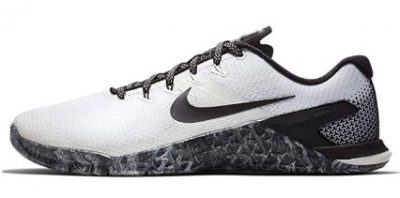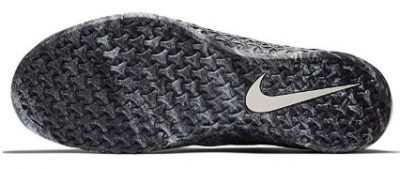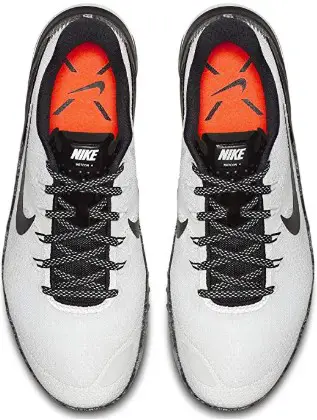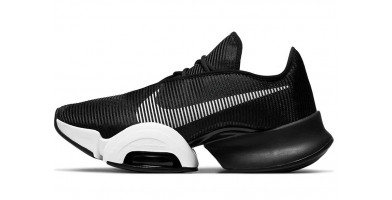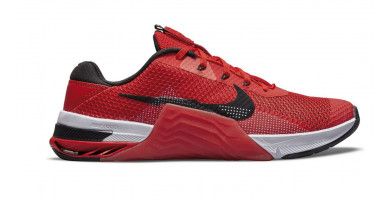Nike Metcon 4 Cross-Training Shoe Review
Everyone knows Nike. Their “Just Do It” slogan continues to inspire your editors, and many others, on low motivation days (see these funny memes to get inspired). We won’t spend a lot of time discussing the company’s background or reputation–those things speak for themselves.
Instead, we are going to drill down on the Nike Metcon 4 cross-training shoe. It released globally on January 4th, 2018. It has not yet been updated with Nike’s Flyknit mesh, though the early Metcon, Metcon 2, and Metcon 3 all have. The entire Metcon line continues to be popular with lifters, runners, and CrossFitters. Metcon 4 is exceptionally durable and stable. It is flexible enough to let your feet move, and the inner and outer linings allow circulating air. The shoe does not have the cushioning for a long-distance run, but 5K and below runners will love the comfort and nimble feel of the shoe.
Part of the secret is in that mesh, which Nike and its fans love. The mesh composition is more durable, flexible, and lightweight than on any other Metcon shoe. This shoe will support you, indoors or out, and will be easy to clean after thanks to the synthetic uppers and linings.
Not a zero drop shoe, but just 4 mm difference from the heel to toe
Excellent stability and a firm ride
Traction on the outsole
The rubber outsole is slightly sticky--helps with stability and planting feet during lifts or jumps
Upper features flywire stitching--tough and lightweight
The outsole is textured but flat, connecting you to the ground or floor
The midsole is firm in the heel--more give towards the front of foot
The tongue is padded for comfort, and there are 6 eyelets (Metcon 3 had 5)
The shoe is pricey and might be more firm than some athletes prefer
Lacks an internal wedge shape that would make it an ideal squat shoe
The Rundown
The light, padded tongue is made of leather and mesh. Some of the eyelets have threads to reinforce them. The heel is not sticky enough to pick up debris but does keep you grounded and make landings more secure if you do box jumps or similar exercises. If you like to climb ropes or rock climbing walls, the adhesion and outsole texturing will help you grip surfaces. The outer shell is sturdy enough, with textured mesh and stitching, to also aid in grip. These shoes are not ideal for indoor or outdoor soccer, but they will work better than most in a pinch. You will stay light on your feet, with the heel cup and a TPU forefoot piece preventing overextension while you sprint, pivot, and juggle or kick the ball with your feet and legs.
The lace closure system is standard. There isn't much extra or special about it. There are no straps, which you sometimes see on CrossFit shoes. Nike wanted to make a shoe versatile enough for all athletes to use, and the continued popularity of the Nike Metcon 4 is the well-received result. It makes us wonder what else the Metcon 5 can possibly have.
Who Is It For?
That's because cross-training is a must for anyone who wants to increase their level of health and fitness or give themselves a better quality of life. Even if you play a sport like a roller derby, you will have to spend some time in the gym without your skates on. regular lifting sessions will give you more stability, more endurance, and an advantage over opponents. It is the same for martial artists. Their lightning-fast attacks, and ability to absorb blows and keep going, is the result of sport-specific conditioning as well as cross-training with weights and a healthy amount of cardio.
Our insistence on cross-training for all naturally leads to a wider discussion about the dangers of isolated exercises. We are talking about certain gym machines, as well as lifts we see people performing every time we step into a gym. Actually, you don't even have to go to the gym. Watch any movie with a scene where the hero is working out, to prepare for a fight or game. There will be at least one extra in the background sitting on a bench doing concentration curls. Or, they will be standing up and curling an EZ-curl bar with both hands.
What's wrong with curls, you ask? Surely the Nike Metcon 4 will support and stabilize you just as well during those lifts. It isn't that isolating a certain muscle, say your bicep or tricep, is wrong. You will gain strength and definition in that area. But it is less effective and efficient than moves that combine muscle groups. You can work those biceps with push-ups--and work your triceps, shoulders, back, and trunk muscles at the same time. Even your legs have a role to play, keeping you planted while you push yourself off the ground or hold yourself still with planks.
The realization that many traditional moves overlook large muscle groups in favor of an isolated area took place about a decade and a half ago. CrossFit, perhaps the most famous response to the realization, first appeared in 2000 and became a household name by 2010. Now there are over 10,000 gyms, just in the United States, that either focus exclusively on CrossFit or offer it as an option. Although cross-training shoes have been around much longer, they have perhaps found their greatest application in CrossFit WODs. A shoe like the Nike Metcon 4 is perfectly suited to the jumping, sprinting, pushing, pulling, lifting, and intense rapid calisthenics that make up a CrossFit WOD.
You don't have to become a CrossFitter to wear and benefit from the Nike Metcon 4. We mentioned they were expensive, but they are also long-lasting and will help prevent injury by providing support and encouraging proper mechanical form. If you work out consistently, enough to experience soreness and need recovery days, the Nike Metcon 4 belongs to your list of options. And if you pursue a specific sport, like cycling or volleyball, we strongly encourage you to take up cross-training if you have not already. Plank circuits and barbell squats may seem boring compared to chasing a ball up and down the court while others try to stop you. But the time you spend doing progressive resistance exercise will pay off in speed, strength, endurance, and explosive power. The Nike Metcon 4 will keep you on solid footing throughout all of it. They are the perfect blend of lightweight and ample cushioning to lead you into jump rope domination--few cardio exercises build strength and burn calories the way jumping rope does.
All About Flywire
Flywire is Nike's proprietary thread, used in the uppers of many of their shoes. It is made of Vectran, a nylon-related thread made by melting and reforming certain crystal polymers. Not many people outside certain industries know exactly how Vectran is made. We do know that it is thinner than human hair, stronger than steel, and used by NASA in aerospace components.
Nike uses it for the embroidery in key parts of the shoe. The areas using Flywire are the trouble spots, where the human foot most needs support from the shoe protecting it. The strategic placement of Flywire is similar to a suspension bridge, which uses specifically spaced cables to support and distribute the weight of all the traffic going across the bridge. Suspension bridges are also less rigid than traditional steel and concrete ones. Nike Metcon 4 is the same way. It is super strong and will support your body for a long time, but has enough flexibility to allow for movement and not break down when placed under pressure.
Flyknit shoes, those with "flyknit" in the name, also use Flywire. But it is present in greater amounts, becoming like a tightly fitting second skin. Flyknit shoes are exceptionally flexible and breathable, making them suitable for long distance runners who won't want to use the Metcon 4 in their sport. While Nike introduced Flywire in 2008, it was not until 2012 that they perfected the technique for an entire shoe and introduced the first-ever flyknit runners to the public.

